Events76 results
About
Frédéric François Chopin was a Polish composer and virtuoso pianist of the Romantic era who wrote primarily for solo piano. He has maintained worldwide renown as a leading musician of his era, one whose "poetic genius was based on a professional technique that was without equal in his generation."
Chopin was born Fryderyk Franciszek Chopin in the Duchy of Warsaw and grew up in Warsaw, which in 1815 became part of Congress Poland. A child prodigy, he completed his musical education and composed his earlier works in Warsaw before leaving Poland at the age of 20, less than a month before the outbreak of the November 1830 Uprising. At 21, he settled in Paris. Thereafter—in the last 18 years of his life—he gave only 30 public performances, preferring the more intimate atmosphere of the salon. He supported himself by selling his compositions and by giving piano lessons, for which he was in high demand. Chopin formed a friendship with Franz Liszt and was admired by many of his other musical contemporaries (including Robert Schumann). In 1835, Chopin obtained French citizenship. After a failed engagement to Maria Wodzińska from 1836 to 1837, he maintained an often troubled relationship with the French writer Amantine Dupin (known by her pen name, George Sand). A brief and unhappy visit to Majorca with Sand in 1838–39 would prove one of his most productive periods of composition. In his final years, he was supported financially by his admirer Jane Stirling, who also arranged for him to visit Scotland in 1848. For most of his life, Chopin was in poor health. He died in Paris in 1849 at the age of 39, probably of pericarditis aggravated by tuberculosis.
All of Chopin's compositions include the piano. Most are for solo piano, though he also wrote two piano concertos, a few chamber pieces, and some 19 songs set to Polish lyrics. His piano writing was technically demanding and expanded the limits of the instrument: his own performances were noted for their nuance and sensitivity. Chopin invented the concept of the instrumental ballade. His major piano works also include mazurkas, waltzes, nocturnes, polonaises, études, impromptus, scherzos, preludes and sonatas, some published only posthumously. Among the influences on his style of composition were Polish folk music, the classical tradition of J.S. Bach, Mozart, and Schubert, and the atmosphere of the Paris salons of which he was a frequent guest. His innovations in style, harmony, and musical form, and his association of music with nationalism, were influential throughout and after the late Romantic period.
Chopin's music, his status as one of music's earliest superstars, his (indirect) association with political insurrection, his high-profile love-life, and his early death have made him a leading symbol of the Romantic era. His works remain popular, and he has been the subject of numerous films and biographies of varying historical fidelity.
Over 230 works of Chopin survive; some compositions from early childhood have been lost. All his known works involve the piano, and only a few range beyond solo piano music, as either piano concertos, songs or chamber music.
Chopin was educated in the tradition of Beethoven, Haydn, Mozart and Clementi; he used Clementi's piano method with his own students. He was also influenced by Hummel's development of virtuoso, yet Mozartian, piano technique. He cited Bach and Mozart as the two most important composers in shaping his musical outlook. Chopin's early works are in the style of the "brilliant" keyboard pieces of his era as exemplified by the works of Ignaz Moscheles, Friedrich Kalkbrenner, and others. Less direct in the earlier period are the influences of Polish folk music and of Italian opera. Much of what became his typical style of ornamentation (for example, his fioriture) is taken from singing. His melodic lines were increasingly reminiscent of the modes and features of the music of his native country, such as drones.
Chopin took the new salon genre of the nocturne, invented by the Irish composer John Field, to a deeper level of sophistication. He was the first to write ballades and scherzi as individual concert pieces. He essentially established a new genre with his own set of free-standing preludes (Op. 28, published 1839). He exploited the poetic potential of the concept of the concert étude, already being developed in the 1820s and 1830s by Liszt, Clementi and Moscheles, in his two sets of studies (Op. 10 published in 1833, Op. 25 in 1837).
Chopin also endowed popular dance forms with a greater range of melody and expression. Chopin's mazurkas, while originating in the traditional Polish dance (the mazurek), differed from the traditional variety in that they were written for the concert hall rather than the dance hall; as J. Barrie Jones puts it, "it was Chopin who put the mazurka on the European musical map." The series of seven polonaises published in his lifetime (another nine were published posthumously), beginning with the Op. 26 pair (published 1836), set a new standard for music in the form. His waltzes were also written specifically for the salon recital rather than the ballroom and are frequently at rather faster tempos than their dance-floor equivalents.
Titles, opus numbers and editions
Some of Chopin's well-known pieces have acquired descriptive titles, such as the Revolutionary Étude (Op. 10, No. 12), and the Minute Waltz (Op. 64, No. 1). However, with the exception of his Funeral March, the composer never named an instrumental work beyond genre and number, leaving all potential extramusical associations to the listener; the names by which many of his pieces are known were invented by others. There is no evidence to suggest that the Revolutionary Étude was written with the failed Polish uprising against Russia in mind; it merely appeared at that time. The Funeral March, the third movement of his Sonata No. 2 (Op. 35), the one case where he did give a title, was written before the rest of the sonata, but no specific event or death is known to have inspired it.
The last opus number that Chopin himself used was 65, allocated to the Cello Sonata in G minor. He expressed a deathbed wish that all his unpublished manuscripts be destroyed. At the request of the composer's mother and sisters, however, his musical executor Julian Fontana selected 23 unpublished piano pieces and grouped them into eight further opus numbers (Opp. 66–73), published in 1855. In 1857, 17 Polish songs that Chopin wrote at various stages of his life were collected and published as Op. 74, though their order within the opus did not reflect the order of composition.
Works published since 1857 have received alternative catalogue designations instead of opus numbers. The present standard musicological reference for Chopin's works is the Kobylańska Catalogue (usually represented by the initials 'KK'), named for its compiler, the Polish musicologist Krystyna Kobylańska.
Chopin's original publishers included Maurice Schlesinger and Camille Pleyel. His works soon began to appear in popular 19th-century piano anthologies. The first collected edition was by Breitkopf & Härtel (1878–1902). Among modern scholarly editions of Chopin's works are the version under the name of Paderewski published between 1937 and 1966 and the more recent Polish "National Edition", edited by Jan Ekier, both of which contain detailed explanations and discussions regarding choices and sources.
Chopin published his music in France, England and the German states due to the copyright laws of the time. As such there are often three different kinds of ‘first editions’. Each edition is different from the other, as Chopin edited them separately and at times he did some revision to the music while editing it. Furthermore, Chopin provided his publishers with varying sources, including autographs, annotated proofsheets and scribal copies. Only recently have these differences gained greater recognition.
Form and harmony
Chopin's last (Pleyel) piano, on which he composed in 1848–49. Fryderyk Chopin Museum, Warsaw
Improvisation stands at the centre of Chopin's creative processes. However, this does not imply impulsive rambling: Nicholas Temperley writes that "improvisation is designed for an audience, and its starting-point is that audience's expectations, which include the current conventions of musical form." The works for piano and orchestra, including the two concertos, are held by Temperley to be "merely vehicles for brilliant piano playing ... formally longwinded and extremely conservative". After the piano concertos (which are both early, dating from 1830), Chopin made no attempts at large-scale multi-movement forms, save for his late sonatas for piano and for cello; "instead he achieved near-perfection in pieces of simple general design but subtle and complex cell-structure." Rosen suggests that an important aspect of Chopin's individuality is his flexible handling of the four-bar phrase as a structural unit.
J. Barrie Jones suggests that "amongst the works that Chopin intended for concert use, the four ballades and four scherzos stand supreme", and adds that "the Barcarolle Op. 60 stands apart as an example of Chopin's rich harmonic palette coupled with an Italianate warmth of melody." Temperley opines that these works, which contain "immense variety of mood, thematic material and structural detail", are based on an extended "departure and return" form; "the more the middle section is extended, and the further it departs in key, mood and theme, from the opening idea, the more important and dramatic is the reprise when it at last comes."
Chopin's mazurkas and waltzes are all in straightforward ternary or episodic form, sometimes with a coda. The mazurkas often show more folk features than many of his other works, sometimes including modal scales and harmonies and the use of drone basses. However, some also show unusual sophistication, for example Op. 63 No. 3, which includes a canon at one beat's distance, a great rarity in music.
Chopin's polonaises show a marked advance on those of his Polish predecessors in the form (who included his teachers Żywny and Elsner). As with the traditional polonaise, Chopin's works are in triple time and typically display a martial rhythm in their melodies, accompaniments and cadences. Unlike most of their precursors, they also require a formidable playing technique.
The 21 nocturnes are more structured, and of greater emotional depth, than those of Field (whom Chopin met in 1833). Many of the Chopin nocturnes have middle sections marked by agitated expression (and often making very difficult demands on the performer) which heightens their dramatic character.
Chopin's études are largely in straightforward ternary form. He used them to teach his own technique of piano playing—for instance playing double thirds (Op. 25, No. 6), playing in octaves (Op. 25, No. 10), and playing repeated notes (Op. 10, No. 7).
The preludes, many of which are very brief (some consisting of simple statements and developments of a single theme or figure), were described by Schumann as "the beginnings of studies". Inspired by J.S. Bach's The Well-Tempered Clavier, Chopin's preludes move up the circle of fifths (rather than Bach's chromatic scale sequence) to create a prelude in each major and minor tonality. The preludes were perhaps not intended to be played as a group, and may even have been used by him and later pianists as generic preludes to others of his pieces, or even to music by other composers, as Kenneth Hamilton suggests: he has noted a recording by Ferruccio Busoni of 1922, in which the Prelude Op. 28 No. 7 is followed by the Étude Op. 10 No. 5.
The two mature piano sonatas (No. 2, Op. 35, written in 1839 and No. 3, Op. 58, written in 1844) are in four movements. In Op. 35, Chopin was able to combine within a formal large musical structure many elements of his virtuosic piano technique—"a kind of dialogue between the public pianism of the brilliant style and the German sonata principle". The sonata has been considered as showing the influences of both Bach and Beethoven. The Prelude from Bach's Suite No. 6 in D major for cello (BWV 1012) is quoted; and there are references to two sonatas of Beethoven: the Sonata Opus 111 in C minor, and the Sonata Opus 26 in A flat major, which, like Chopin's Op. 35, has a funeral march as its slow movement.The last movement of Chopin's Op. 35, a brief (75-bar) perpetuum mobile in which the hands play in unmodified octave unison throughout, was found shocking and unmusical by contemporaries, including Schumann. The Op. 58 sonata is closer to the German tradition, including many passages of complex counterpoint, "worthy of Brahms" according to the music historians Kornel Michałowski and Jim Samson.
Chopin's harmonic innovations may have arisen partly from his keyboard improvisation technique. Temperley says that in his works "novel harmonic effects frequently result from the combination of ordinary appoggiaturas or passing notes with melodic figures of accompaniment", and cadences are delayed by the use of chords outside the home key (neapolitan sixths and diminished sevenths), or by sudden shifts to remote keys. Chord progressions sometimes anticipate the shifting tonality of later composers such as Claude Debussy, as does Chopin's use of modal harmony.
Technique and performance style
In 1841, Léon Escudier wrote of a recital given by Chopin that year, "One may say that Chopin is the creator of a school of piano and a school of composition. In truth, nothing equals the lightness, the sweetness with which the composer preludes on the piano; moreover nothing may be compared to his works full of originality, distinction and grace." Chopin refused to conform to a standard method of playing and believed that there was no set technique for playing well. His style was based extensively on his use of very independent finger technique. In his Projet de méthode he wrote: "Everything is a matter of knowing good fingering ... we need no less to use the rest of the hand, the wrist, the forearm and the upper arm." He further stated: "One needs only to study a certain position of the hand in relation to the keys to obtain with ease the most beautiful quality of sound, to know how to play short notes and long notes, and unlimited dexterity." The consequences of this approach to technique in Chopin's music include the frequent use of the entire range of the keyboard, passages in double octaves and other chord groupings, swiftly repeated notes, the use of grace notes, and the use of contrasting rhythms (four against three, for example) between the hands.
Jonathan Bellman writes that modern concert performance style—set in the "conservatory" tradition of late 19th- and 20th-century music schools, and suitable for large auditoria or recordings—militates against what is known of Chopin's more intimate performance technique. The composer himself said to a pupil that "concerts are never real music, you have to give up the idea of hearing in them all the most beautiful things of art." Contemporary accounts indicate that in performance, Chopin avoided rigid procedures sometimes incorrectly attributed to him, such as "always crescendo to a high note", but that he was concerned with expressive phrasing, rhythmic consistency and sensitive colouring. Berlioz wrote in 1853 that Chopin "has created a kind of chromatic embroidery ... whose effect is so strange and piquant as to be impossible to describe ... virtually nobody but Chopin himself can play this music and give it this unusual turn". Hiller wrote that "What in the hands of others was elegant embellishment, in his hands became a colourful wreath of flowers."
Chopin's music is frequently played with rubato, "the practice in performance of disregarding strict time, 'robbing' some note-values for expressive effect". There are differing opinions as to how much, and what type, of rubato is appropriate for his works. Charles Rosen comments that "most of the written-out indications of rubato in Chopin are to be found in his mazurkas ... It is probable that Chopin used the older form of rubato so important to Mozart ... the melody note in the right hand is delayed until after the note in the bass ... An allied form of this rubato is the arpeggiation of the chords thereby delaying the melody note; according to Chopin's pupil Karol Mikuli, Chopin was firmly opposed to this practice."
Friederike Müller, a pupil of Chopin, wrote: " playing was always noble and beautiful; his tones sang, whether in full forte or softest piano. He took infinite pains to teach his pupils this legato, cantabile style of playing. His most severe criticism was 'He—or she—does not know how to join two notes together.' He also demanded the strictest adherence to rhythm. He hated all lingering and dragging, misplaced rubatos, as well as exaggerated ritardandos ... and it is precisely in this respect that people make such terrible errors in playing his works."
Polish heritage
With his mazurkas and polonaises, Chopin has been credited with introducing to music a new sense of nationalism. Schumann, in his 1836 review of the piano concertos, highlighted the composer's strong feelings for his native Poland, writing that "Now that the Poles are in deep mourning, their appeal to us artists is even stronger ... If the mighty autocrat in the north could know that in Chopin's works, in the simple strains of his mazurkas, there lurks a dangerous enemy, he would place a ban on his music. Chopin's works are cannon buried in flowers!" The biography of Chopin published in 1863 under the name of Franz Liszt (but probably written by Carolyne zu Sayn-Wittgenstein) states that Chopin "must be ranked first among the first musicians ... individualizing in themselves the poetic sense of an entire nation."
Some modern commentators have argued against exaggerating Chopin's primacy as a "nationalist" or "patriotic" composer. George Golos refers to earlier "nationalist" composers in Central Europe, including Poland's Michał Kleofas Ogiński and Franciszek Lessel, who utilised polonaise and mazurka forms. Barbara Milewski suggests that Chopin's experience of Polish music came more from "urbanised" Warsaw versions than from folk music, and that attempts (by Jachimecki and others) to demonstrate genuine folk music in his works are without basis. Richard Taruskin impugns Schumann's attitude toward Chopin's works as patronizing and comments that Chopin "felt his Polish patriotism deeply and sincerely" but consciously modelled his works on the tradition of Bach, Beethoven, Schubert, and Field.
A reconciliation of these views is suggested by William Atwood: "Undoubtedly use of traditional musical forms like the polonaise and mazurka roused nationalistic sentiments and a sense of cohesiveness amongst those Poles scattered across Europe and the New World ... While some sought solace in, others found them a source of strength in their continuing struggle for freedom. Although Chopin's music undoubtedly came to him intuitively rather than through any conscious patriotic design, it served all the same to symbolize the will of the Polish people ..."
Reception and influence
Jones comments that "Chopin's unique position as a composer, despite the fact that virtually everything he wrote was for the piano, has rarely been questioned." He also notes that Chopin was fortunate to arrive in Paris in 1831—"the artistic environment, the publishers who were willing to print his music, the wealthy and aristocratic who paid what Chopin asked for their lessons"—and these factors, as well as his musical genius, also fuelled his contemporary and later reputation. While his illness and his love-affairs conform to some of the stereotypes of romanticism, the rarity of his public recitals (as opposed to performances at fashionable Paris soirées) led Arthur Hutchings to suggest that "his lack of Byronic flamboyance his aristocratic reclusiveness make him exceptional" among his romantic contemporaries, such as Liszt and Henri Herz.
Chopin's qualities as a pianist and composer were recognized by many of his fellow musicians. Schumann named a piece for him in his suite Carnaval, and Chopin later dedicated his Ballade No. 2 in F major to Schumann. Elements of Chopin's music can be traced in many of Liszt's later works. Liszt later transcribed for piano six of Chopin's Polish songs. A less fraught friendship was with Alkan, with whom he discussed elements of folk music, and who was deeply affected by Chopin's death.
Two of Chopin's long-standing pupils, Karol Mikuli (1821–1897) and Georges Mathias, were themselves piano teachers and passed on details of his playing to their own students, some of whom (such as Raoul Koczalski) were to make recordings of his music. Other pianists and composers influenced by Chopin's style include Louis Moreau Gottschalk, Édouard Wolff (1816–1880) and Pierre Zimmermann. Debussy dedicated his own 1915 piano Études to the memory of Chopin; he frequently played Chopin's music during his studies at the Paris Conservatoire, and undertook the editing of Chopin's piano music for the publisher Jacques Durand.
Polish composers of the following generation included virtuosi such as Moritz Moszkowski, but, in the opinion of J. Barrie Jones, his "one worthy successor" among his compatriots was Karol Szymanowski (1882–1937). Edvard Grieg, Antonín Dvořák, Isaac Albéniz, Pyotr Ilyich Tchaikovsky and Sergei Rachmaninoff, among others, are regarded by critics as having been influenced by Chopin's use of national modes and idioms. Alexander Scriabin was devoted to the music of Chopin, and his early published works include nineteen mazurkas, as well as numerous études and preludes; his teacher Nikolai Zverev drilled him in Chopin's works to improve his virtuosity as a performer. In the 20th century, composers who paid homage to (or in some cases parodied) the music of Chopin included George Crumb, Bohuslav Martinů, Darius Milhaud, Igor Stravinsky and Heitor Villa-Lobos.
Chopin's music was used in the 1909 ballet Chopiniana, choreographed by Michel Fokine and orchestrated by Alexander Glazunov. Sergei Diaghilev commissioned additional orchestrations—from Stravinsky, Anatoly Lyadov, Sergei Taneyev and Nikolai Tcherepnin—for later productions, which used the title Les Sylphides.
Chopin's music remains very popular and is regularly performed, recorded and broadcast worldwide. The world's oldest monographic music competition, the International Chopin Piano Competition, founded in 1927, is held every five years in Warsaw. The Fryderyk Chopin Institute of Poland lists on its website over eighty societies worldwide devoted to the composer and his music. The Institute site also lists nearly 1,500 performances of Chopin works on YouTube as of January 2014.





